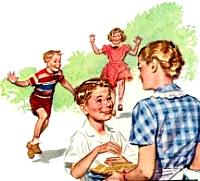 According to the Centers for Disease Control, childhood obesity has more than tripled since 1970. In fact, the prevalence for children between the ages of 6 and 11 has gone from 6.5% to 19.6% in 2008. Those statistics are startling and provide a somber look at just how much we’ve come to rely upon refined sugars and convenience foods.
According to the Centers for Disease Control, childhood obesity has more than tripled since 1970. In fact, the prevalence for children between the ages of 6 and 11 has gone from 6.5% to 19.6% in 2008. Those statistics are startling and provide a somber look at just how much we’ve come to rely upon refined sugars and convenience foods.
But there’s more to it than just a few extra pounds our children are carrying. The physical and psychological tolls can be devastating and affect a child into his adulthood. Everything from cardiovascular disease to diabetes to sleep apnea has been associated with childhood obesity. So what can you, as a child care provider, do to offset these potential problems? While it may seem as though any efforts on your part, in your capacity as a provider, would be offset by a child’s unhealthy lifestyle, you might be surprised to learn that those little things will actually stick with a child as he grows older. This is one reason it’s so important to encourage physical activity and to stress the benefits of choosing an apple over a cookie. Often, many children don’t have access at home to healthier food choices, such as fruit and veggies. And too, kids will often dismiss fresh veggies not because they’ve tried them and really don’t like them, but because it’s just their first reaction. Making it fun is key.
One way of doing this is by encouraging a child to participate in age appropriate ways. Many child care centers are allowing little ones to plant small gardens. Even if it’s just a few strawberry plants and even tomato plants or cucumbers, it gives them a sense of pride in knowing they’re responsible for those yummy strawberries they’re now washing and getting ready to share. It’s fantastic for everyone, but most importantly, it allows these kids to take the knowledge with them into their adulthood when they’re not only making food decisions for themselves, but for their children too.
You might not be able to eradicate childhood obesity on your own, but you can certainly influence those children who  are fortunate enough to have you as their child care providers. A few small changes is all it takes for potential major changes later on.
are fortunate enough to have you as their child care providers. A few small changes is all it takes for potential major changes later on.
Be sure to visit our site, too for more information on how to make your child care center more efficient.




